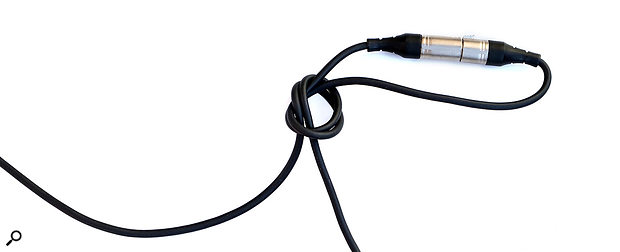 It’s fine to join mic cables together, but it can place strain on the XLR connectors that could see them come unplugged! Knotting the cables as illustrated here should prevent problems.
It’s fine to join mic cables together, but it can place strain on the XLR connectors that could see them come unplugged! Knotting the cables as illustrated here should prevent problems.
If a single mic cable isn’t long enough but two plugged together will reach, should I let that worry me or can I go ahead and sleep easier at nights? (Assuming the cables and plugs are good quality, and the context is studio recording rather than live sound.)
SOS Forum post
SOS Technical Editor Hugh Robjohns replies: There are no real issues in extending mic cables with more mic cables when necessary — I’m sure we all do it frequently without any problems. For example, I routinely use thin, flexible, and short (eight-inch) cables from the mic (to avoid transmitting vibration across a shock-mount), connected to a heavy-duty mic cable (secured to the stand), and then that usually plugs into a snake back to the mixing position, with another short XLR tail from the snake into the recorder or DAW interface. And I sleep very well at night! However, there are a few pointers to bear in mind when linking multiple XLR cables...
The more connection points in a cable run, the greater the risk of failure, disconnection, distortion or interference. So it’s always best to run a single long cable if you can, rather than two or three short ones joined together.
Most commercial cables are made with the XLR shell wired to pin 1, to ensure the shell acts as part of the screen. This is helpful, as the core signal wires are inherently lacking the cable shield inside the XLR shell, and so by connecting the shell to pin 1 the risk of interference pickup is minimised. The downside of this construction practice, though, is that if the XLR shells touch something earthed (like a radiator, wet grass, etc) they will almost certainly create an unexpected ground loop with all the attendant hums and buzzes. So just be careful where you lay the XLR joint.
Most people making their own cables don’t bother to link the shell to pin 1; after all, there’s no real need, since the shell is automatically grounded to pin 1 anyway when plugged into any hardware device. And when cables made this way are joined together it doesn’t matter if the shell accidentally touches anything else, since it’s isolated from the cable screen ground circuit. However, the potential downside of this arrangement is that interference pickup could become a problem, as the cable wires inside the XLR plugs have no effective shielding. Thankfully, I can’t recall this ever causing a problem in practice, and I think it would only become a concern in extremely ‘hostile’ conditions where there’s powerful radio frequencies being radiated nearby.
A more practical concern is if the cable is likely to be trodden upon, tugged or has to support any weight (such as if strung between posts), since the latch on an XLR is not guaranteed to be reliable. So, it makes sense to try to keep the connectors well out of the way of anyone’s feet, and I habitually tie an overhand knot in the two cables [shown above] so that if someone trips over the cable and gives it a strong tug the knot takes the strain and not the XLR latches.
